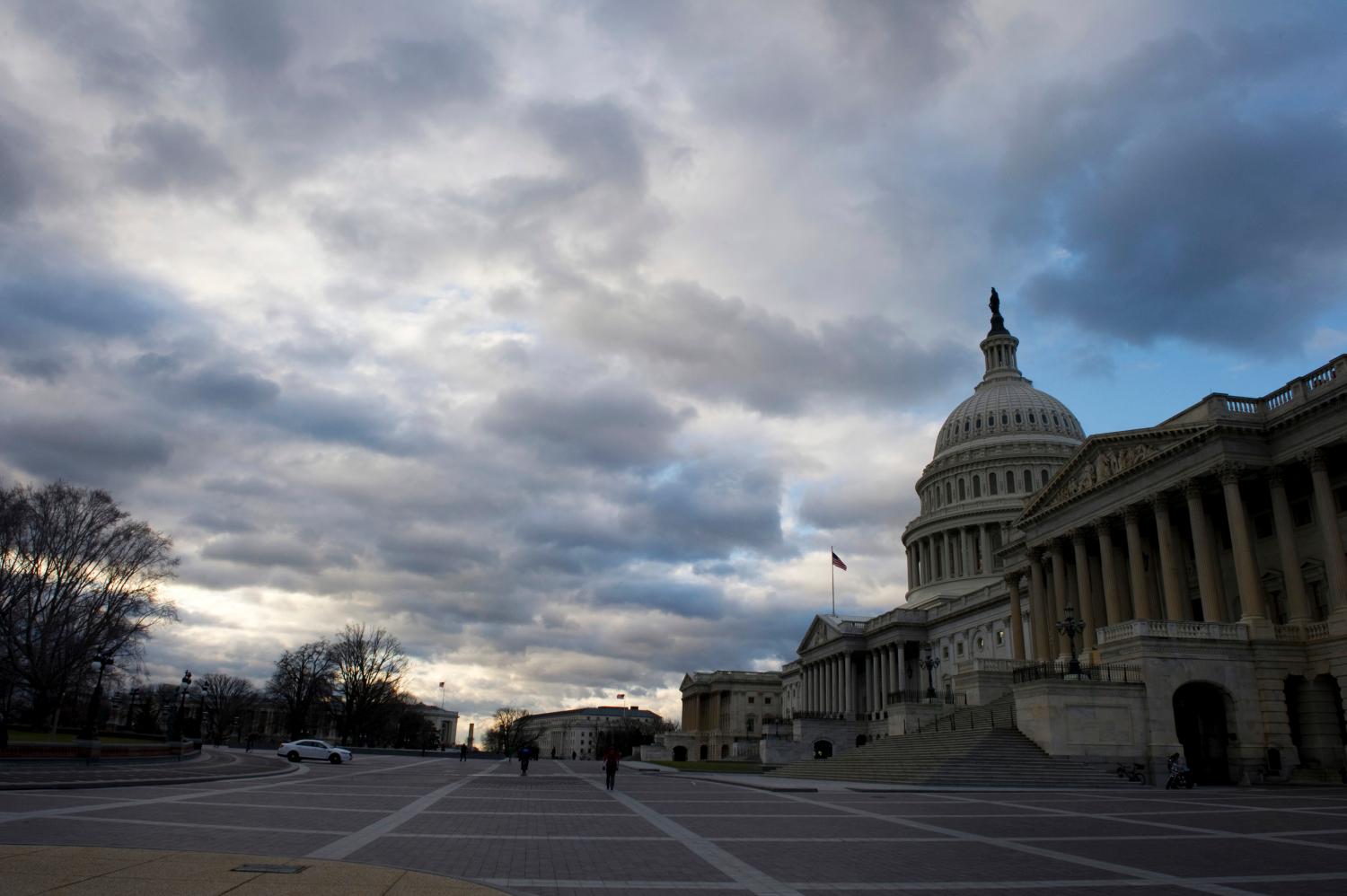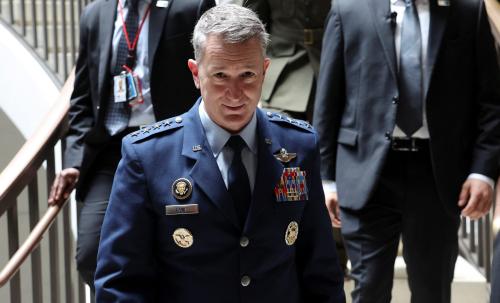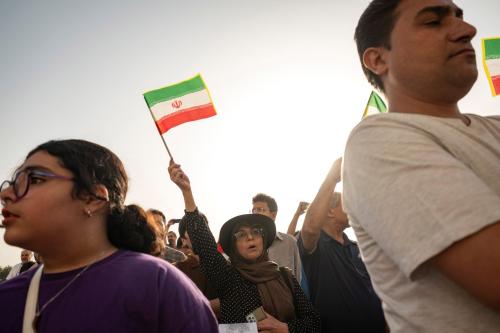The United States—together with regional allies South Korea and Japan as well as China and Russia—needs a new North Korea policy to handle the rapidly intensifying nuclear crisis in Northeast Asia. The current Bush administration policy of refusing to talk until Pyongyang changes course stands too great a chance of failing.
Either North Korea has decided that it needs a substantial nuclear arsenal to avoid being the next target of President Bush’s new policy of preemption, and of regime change in particular, or it is engaging in brinkmanship because it cannot think of any other way to convince the world community to provide it more aid and diplomatic recognition. Or a mix of the two.
Any policy needs to account for all of the possibilities. The Bush administration should outline a policy toward North Korea that is defined by tough conditions—including efforts to scale back conventional arms on the peninsula—but one that holds the possibility of engagement, normalization of diplomatic ties, and more aid.
POLICY BRIEF #114
Tough Conditions
At present, the Bush administration is unwilling to negotiate with North Korea, insisting it first dismantle its nuclear programs. However, with the possible exception of Japan, America’s major northeast Asian security partners do not appear inclined to support such a strategy, or any possible tightening of the screws on Pyongyang. Moreover, North Korea has limited dealings with the outside world. Its total trade is about $1 billion a year (roughly half with China, and most of the rest with Japan and South Korea). Apart from food, most of its aid now comes from China alone. So the threat of further economic and diplomatic sanctions may not influence it strongly in any event, and almost certainly not without Beijing’s active support. Finally, North Korea’s collapse has been predicted for a decade and hardly seems imminent now.
Military Options
North Korea probably has a nuclear arsenal of one or two bombs built with plutonium it extracted from its small “research reactor” at Yongbyon in 1989. By extracting additional plutonium from the spent fuel that was used in that reactor up until 1994, North Korea could probably increase the size of its nuclear arsenal to six to eight bombs in 2003. It could have a dozen by mid-decade.
U.S. military options are limited. U.S. and South Korean armed forces could in theory destroy the two larger nuclear reactors still under construction at Yongbyon before they could be finished, an option Secretary of Defense William J. Perry once raised publicly during the Clinton administration. Doing so could prevent North Korea from ultimately developing a dozen or more bombs a year. North Korea might strike back against South Korea, and the result could be all-out war on the peninsula, with the likelihood of hundreds of thousands of deaths including many thousands of American soldiers.
But even if that risk were incurred, the two large reactors are not the immediate issue. The issue today is the existing plutonium in the spent fuel from the smaller reactor, as well as the possibility that the smaller reactor will soon be restarted and produce even more plutonium. The United States and its allies might slow this process with a military strike against the reprocessing facility or the spent fuel rods at Yongbyon, but only at some risk of spewing radioactivity into the atmosphere. Moreover, North Korea may soon move the rods to a location that is more difficult to hit. This military option may have to be eventually considered by Washington and Seoul, but it is quite unappealing.
North Korea would be unlikely to deliberately start a war even if it had a dozen nuclear weapons. Nor are any of its nuclear weapons likely to be small enough to fit on its missiles. But should war somehow occur in the future, with an arsenal of eight or more bombs, at least one probably could be successfully detonated against allied forces or civilian populations, and there is also the danger that North Korea would sell fissile material to other countries or even terrorist groups to garner desperately needed cash. A North Korean nuclear arsenal would also risk sparking a nuclear arms race in Northeast Asia that could lead to the nuclearization of South Korea and Japan and perhaps even Taiwan. Despite Secretary of State Colin Powell’s recent claim to the contrary, the situation is very much a crisis, and a major one at that.
The Bush administration needs to devote much more serious attention to the problem not only by being open to indirect talks with Pyongyang, but also by developing, along with its allies, an agenda for such talks. The point should be to offer North Korea an alternative future to the path it has recently chosen. That alternative should include incentives, but also stiff demands on the regime of President Kim Jong-Il—on issues ranging from the nuclear crisis to missile exports to Japanese kidnapping victims to conventional forces on the peninsula. This approach would emulate Ronald Reagan’s tough negotiation strategy with the Soviet Union in the 1980s, and his “trust but verify” concept as well.
The Clinton Legacy
When entering office, President Bush understandably wanted to revise the Clinton administration’s approach to North Korea. The latter had a number of important accomplishments over roughly a five-year stretch from 1994 to 1999, but it had stalled by 2000.
The Clinton administration helped produce the important 1994 Agreed Framework, under which North Korea effectively froze its major nuclear programs and promised effectively to undo whatever nuclear weapons progress it had earlier made at its small research reactor (the same one now at issue). At the time, the United States and allies South Korea and Japan were accused of giving in to North Korean blackmail, but the deal they signed was a smart one: energy in exchange for energy and nonproliferation.
Washington and its allies did not provide $4 billion in cash for Pyongyang, as often claimed by critics, but instead provided the dollar equivalent of a $4 billion value to produce energy that the Yongbyon nuclear facilities would otherwise have produced. If the deal had a flaw, it was that it left North Korea in possession of its spent fuel rods for too long, though it is not obvious that Pyongyang would have agreed to quickly surrender them. It also promised North Korea new types of nuclear reactors, purportedly—proliferation resistant—but not entirely free from the danger of having their spent fuel ultimately diverted to weapons purposes by the North Korean regime. But those reactors will almost certainly not be completed, so at worst the 1994 accord bought time.
Following the accord, a process of diplomacy and engagement began on the peninsula, involving summits between the leaders of the two Koreas, South Korean tourist visits into North Korea, and some reunions for families separated since the Korean War. After a North Korean long-range missile test over Japanese territory in 1998, Pyongyang adopted a moratorium on future testing, which remains in place (though it is scheduled to end in 2003).
This engagement process slowed by 2000. North Korea stalled on its promises to continue the series of summits and family exchanges. It provoked military clashes at sea. And meanwhile, though not known at the time to U.S. and allied intelligence, it had initiated a secret uranium enrichment program to add to its nuclear stockpile.
The Clinton administration continued to try to engage North Korea even as détente weakened. Secretary of State Madeleine K. Albright visited Pyongyang. President Bill Clinton considered a trip as well, if his administration had first been able to clinch a deal that would buy out North Korea’s missile programs and end its missile exports in return for compensation worth perhaps several hundred millions dollars a year.
North Korean missile exports did not violate international law, and constituted virtually the only remaining export of the cash-starved regime. By compensating North Korea for ending the exports, the Clinton administration hoped to solve the main problem North Korea posed to the United States on the broader global stage in a manner satisfactory to all concerned.
But this approach risked encouraging North Korea to use extortion as its main tool of interaction with the outside world. Moreover, a fix that did little to reform North Korea’s economy would probably have proved only temporary, making it likely that Pyongyang would try to play a similar game at a later date with other weapons. And whatever one thinks of the Clinton approach, it clearly needed to be revised once the United States uncovered evidence of North Korea’s illegal and illegitimate uranium enrichment program by the summer of 2002.
The Bush Policy to Date
President Bush has taken a very hard- line and also a rather disengaged approach to North Korea since the start of his administration. In the winter of 2001, he turned a cold shoulder to South Korean president Kim Dae Jung, known for his “sunshine policy” of engagement towards Pyongyang, when Kim visited Washington to request continued U.S. support for that policy. The Bush administration mused publicly that North Korea should reduce its threatening conventional military forces prior to receiving any additional U.S. help or diplomatic attention, but never translated that sentiment into a concrete policy proposal. After September 11, President Bush lumped North Korea into an axis of evil with Iran and Iraq, even though North Korea posed different sorts of challenges (for example, it now has few if any real links to terrorists) and even though recent history suggested it could be influenced through engagement.
After U.S. intelligence uncovered evidence of North Korea’s illicit uranium enrichment program by the summer of 2002, the Bush administration demanded that North Korea verifiably dismantle that program before diplomacy could begin. It has also suspended fuel oil shipments to North Korea as pledged under the 1994 Agreed Framework. That step is justified in one sense, given North Korea’s violations of its nonproliferation obligations under that accord (and the Non-Proliferation Treaty). But it also reduces U.S. leverage with Pyongyang in the future.
Thus the United States now finds itself in a dilemma. Having just removed monitors and seals from its stock of waste fuel primarily produced in the early 1990s, and having just expelled U.N. monitoring personnel, North Korea is now in a position to add to its arsenal of one or two bombs by producing perhaps half a dozen more within months. That means it can probably do so before outside economic pressure leads to regime collapse or capitulation, even if Washington could somehow convince Beijing and Seoul to join a strategy of strangulation. Moreover, adopting such a policy would surely hurt North Korea’s already beleaguered—and often starving—civilian population before it would affect the Kim Jong-Il regime.
A New Policy
The Bush administration is correct in its assertion that the United States must adopt a tough policy towards North Korea. But it is wrong in its assumption that a tough policy should preclude negotiations.
In early 2001, the Bush administration stated that North Korea would need to reduce its threatening conventional force posture if it wished more aid and diplomatic relations with the United States. But President Bush never translated his administration’s view into a road map for improved relations and North Korean reform.
Although its nuclear and missile programs constitute the more immediate threat, North Korea’s conventional forces are unacceptably large and dangerous. They could produce tens of thousands of casualties in Seoul through artillery attack alone. Because keeping them funded requires approximately 20-25 percent of North Korea’s feeble gross domestic product, any policy leaving them intact will preclude hope for gradual economic reform in the North.
Seoul, Tokyo, and Washington should propose a grand diplomatic bargain—or at least a broad, long-term road map—that would require Pyongyang to:
- Verifiably end all of its nuclear programs, allowing on-site inspections of its uranium enrichment facilities as well as inspections of suspicious sites, and resealing the unprocessed plutonium at immediate issue today
- Reaffirm its commitment to allow its spent fuel rods to be taken out of the country, and to eliminate whatever nuclear weapons it now has. Ideally it would agree to speed up these measures, though it may not be realistic to think it will implement them immediately
- Stop selling missiles abroad and ban all flight testing of longer-range missiles
- Let all Japanese kidnapping victims and their families leave North Korea
- Make large (though not unilateral) cuts in conventional forces, as well as reductions in its forward-deployed military capabilities near the demilitarized zone (DMZ) As part of the agreement, South Korea, Japan, and the United States, as well as other interested parties such as China, would keep food as well as fuel oil flowing, on humanitarian grounds and as a show of good faith. Once the North Koreans accepted the above package, the allies would also begin to provide large amounts of economic aid. Japan is eventually expected to provide up to $10 billion as a form of compensation for its colonization of North Korea in the first half of the twentieth century.
The United States would sign a peace treaty and open up diplomatic relations. If requested, America would provide technical development aid as well—though China’s help might be more important and appreciated in this regard—and would also lead efforts to help North Korea develop new energy sources. However, given what the Bush administration now knows about North Korea’s trustworthiness, those sources cannot involve nuclear capable facilities of any kind.
This plan would be presented as an integral whole. Only in that way would it stand a chance of grabbing the attention and focusing the imagination of North Korean leaders, offering them an alternative vision for the future. In reality, however, it could be developed in stages if that proved more feasible. And it would be phased in incrementally in any event, because it would take time to work out the details of various arms accords and considerable time to implement an effective aid program for North Korea. But the expansion of North Korea’s nuclear arsenal would have to be verifiably stopped right away.
What if this approach does not work? First, given past North Korean negotiating behavior, there is good reason to think it will work. But if it fails, the Bush administration’s policy of containment, coupled with military strikes against the uncompleted North Korean nuclear reactors, and the small reactor and spent fuel rods, may have to be seriously contemplated. Strang-ulation may be America’s only hope at that point, short of all-out war or the opening of a nuclear Pandora’s box in Northeast Asia and beyond. Regional support for such an option, especially critical in regard to South Korea and China, might be more obtainable if other options failed. But it is premature to fall back on that undesirable approach today.
Fleshing Out the Conventional Arms Accord
Most individual elements of the above “grand bargain” are familiar from past policy debates or are relatively simple to conceptualize. But one part that is complicated is the linchpin of the whole idea—the proposed cuts in conventional forces, to be verified by on-site inspections. This is the piece that allows the United States and its allies to engage in negotiations with North Korea without effectively giving in to extortion. Since we would be broadening the agenda with additional tough demands on Pyongyang, we would not simply be capitulating to a North Korean policy of brinkmanship. So how would a conventional forces accord be structured? Some have proposed mutual force pullbacks from the parts of North Korea and South Korea near the DMZ. That idea has merit, and should be part of any accord, but is insufficient by itself. It could quickly be reversed; in addition, it does nothing to lessen the economic burden placed on North Korea by its retention of excessively large armed forces.
Under this kind of accord, styled after the (Conventional Forces in Europe) CFE Treaty, heavy weaponry would be verifiably limited on the entire Korean peninsula. The United States would probably keep all of its 37,000 forces in South Korea since that number is quite modest when set against the million-strong DPRK military and the 600,000-strong Republic of Korea (ROK) armed forces. But South Korea, though outgunned quantitatively, has a much better military than North Korea in most ways. As such, it can afford to make modest cuts in older equipment inventories to go along with larger cuts by North Korea.
The United States, South Korea, and North Korea could agree to common weapons ceilings on major armored vehicles and aircraft that would apply equally on each side of the DMZ. If the force levels were set somewhat below current allied holdings, say 10 to 25 percent below those levels, South Korea would make modest cuts while North Korea made much larger ones.
But the allies could also settle for a less favorable deal without any harm to their military position. As Army officer Pedro Almeida and I argued in an article in the British journal Survival in 1999, uniform 50 percent cuts in holdings of major combat systems on both sides of the DMZ would be militarily acceptable for South Korea and the United States. Under this proposal, each side would make the same proportional cuts in its existing weaponry. Thus North Korea, with the larger equipment inventories, would still make the larger cuts, but South Korea’s reductions would be substantial as well.
Military analysis shows that this kind of 50 percent plan would aid North Korea in a couple of modest ways, notably by increasing the relative importance of infantry and special forces (since manpower could not and would not be limited under this type of treaty). But it would serve ROK/U.S. interests even more—by allowing the allies to retain most of their best weaponry, by increasing the relative military importance of U.S. forces in Japan and U.S. reinforcements from outside the region, and by increasing the relative importance of unconstrained military technologies in which the allies excel, such as advanced reconnaissance and communications systems and antitank weapons.
One final option, and perhaps the best compromise solution, is to start with a CFE-like approach but then modify it. The two sides would be held to the same quantitative limits on heavy weaponry and aircraft, but North Korea could be offered certain exemptions to allow it a modest quantitative edge. For example, taking a page out of the CFE Treaty, North Korea might be allowed to define a certain number of its security units as internal security forces and have them exempted from treaty limits. These measures would provide tacit acknowledgment of the fact that allied weapons are much more capable than North Korean weapons, and that the United States possesses an overwhelming reinforcement capability in Japan, Hawaii, Alaska, and the continental United States.
Conclusion
Some would consider any offer of further aid to North Korea a reward for blackmail. But it is crucial that Washington get involved now, and the package deal proposed here would be one with tough conditions. North Korea would not get half the aid by making good only on nuclear and missile programs, for example, because such an approach would reaffirm its policy of extortion. By adding conventional forces to the equation, the United States would be setting much of the agenda, and also forcing North Korea to make fundamental choices about the future nature of the regime and about economic reform.
The Brookings Institution is committed to quality, independence, and impact.
We are supported by a diverse array of funders. In line with our values and policies, each Brookings publication represents the sole views of its author(s).




